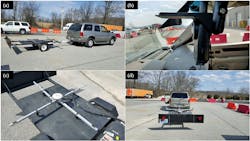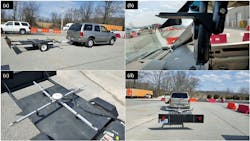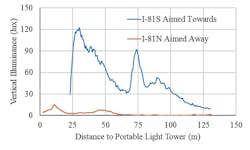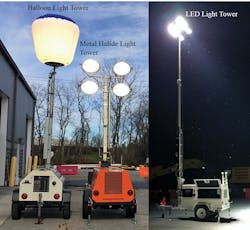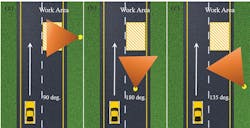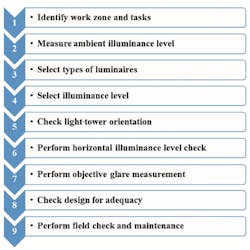By: Rajaram Bhagavathula, Ph.D.
In 2016, there were over 288 nighttime crashes in work zones, resulting in over 800 fatalities.
Increasing traffic volumes are leading to a rapid increase in nighttime construction activities on our roads. This increase in nighttime construction on highways poses a major safety concern for both workers and motorists, as night traffic volumes are low and travel speeds are high.
Figure 1. TRLMMS developed at VTTI: (a) TRLMMS hitched to vehicle; (b) Illuminance meter that measures the vertical illuminance mounted to the windshield; (c) “Spider” apparatus with GPS unit in the center; and (d) TRLMMS from behind with the headlamp barrier eliminating the influence of the following vehicle’s headlamps.
Visibility is key
Visibility is an important factor in nighttime construction work on roadways. The light levels in a work zone should provide light enough so that workers can complete their tasks safely and efficiently. In addition, the light levels also should make workers and the work zone itself more visible to the motorists approaching the work zone. While increasing the light levels in a work zone tends to increase visibility for the workers, it also could increase glare for oncoming motorists. Glare reduces visibility for motorists and could preclude them from seeing workers and obstacles in the work zone. Further, increasing the light levels will only increase the visibility up to certain levels, beyond which any increase could negatively impact safety by increasing glare. Thus, light levels for work zones should be carefully designed so that they can ensure a high level of visibility for workers and motorists without causing glare.
Figure 2. Change in the vertical illuminance as the vehicle gets closer to the portable light tower when aimed towards and away from the travel lane.
The problem with measuring glare
For the purpose of lighting work zones, contractors typically use portable light towers. These portable light towers, when aimed improperly, can significantly increase the glare for motorists entering the work zone. The issue of glare becomes even more important on limited access highways with higher speeds and, as a result, require longer stopping distances for motorists.
The issue of glare from work-zone lighting has led 30 states in the U.S. to mention “reducing glare” in their respective work-zone lighting specifications. However, only two states (Louisiana and New York) have detailed, quantifiable glare specifications (recommended light positions, angles, maximum light levels, etc.) A majority of the states specify that the contractors must take actions to prevent, minimize or reduce glare for drivers. Nine states specify that glare should be evaluated subjectively or by performing a drive-through at setup. Subjective evaluations have the inherent bias of the engineer/inspector performing the evaluation. Subjective evaluations only at setup also ignore the glare when light tower orientation is changed during the course of the construction work.
NCHRP Report 498: Illumination Guidelines for Nighttime Highway Work specifies task-dependent lighting levels for work-zone lighting. It also lists strategies to reduce glare but does not recommend an objective way to measure glare for motorists. Thus, existing specifications do not provide sufficient guidance for reducing glare for motorists in the work zones. Furthermore, there is currently no way to objectively measure glare in-situ at work zones. Glare can be quantified by calculating veiling luminance, but veiling luminance cannot be calculated quickly, as it involves measuring the angles of glare source, illuminance of glare source and background luminance. Having an easy-to-measure, objective measure of glare could help in easily determining if the orientation and the positioning of the portable light towers is a source of glare to the motorists.
Figure 3. Light towers used in the study.
Light levels and visibility in work zones
Recent research conducted by the Virginia Tech Transportation Institute (VTTI) aimed to address the issue of glare in work zones by: (1) Conducting an on-site evaluation of light levels in work zones in Virginia; (2) recommending light-tower positions and orientations that will result in lower glare for motorists; (3) identifying an objective measure of glare and recommend acceptable levels of glare based on this measure; and (4) developing a protocol to evaluate work-zone lighting.
For measuring light levels in work zones, lighting data were collected from 10 active nighttime work zones in Virginia. Horizontal light levels (light incident on the road) were measured in both the vehicle travel lanes and the lane closed for construction work. In addition to horizontal light levels, vertical light levels at the driver’s eye level from inside the vehicle (which can be used as a measure for glare) also were measured. Light levels were measured by a VTTI-developed light measuring system called the Trailer Mounted Mobile Light Measuring System (TRLMMS) (Figure 1). TRLMMS helped measure light levels on roadways without having to stop. TRLMMS is equipped with light meters and a high-precision GPS which enables measuring light levels along with their GPS coordinates. Results from the on-site evaluation of light levels in the work zone showed the horizontal light levels in the work zones were significantly higher than those specified in the NCHRP Report 498. In some cases, these levels were more than 10 times the recommended levels.
In addition, the results also showed that aiming the portable light towers into the travel lane in the work zone increases the vertical illuminance levels at the driver’s eye level (Figure 2). These higher vertical illuminance levels can increase the glare perceived by the motorists.
For the second phase of the research, a human-factors evaluation of three kinds of commercially available light towers was conducted to understand the effect of light tower types and their orientations on visibility, glare and driver behavior. This human-factors evaluation also helped identify an objective measure of glare, and recommend illuminance levels and light-placement orientations that can reduce glare for motorists.
For the human-factors evaluation, a realistic work zone was setup on the Virginia Smart Road, a one-of-its-kind test track built to U.S. highway specifications. The simulated work zone resembled an active nighttime work zone on a limited access highway in Virginia with appropriate signage leading to the work zone and merge tapers. Three types of portable light towers were used (Figure 3). The first was a metal halide portable light tower with four 1,000-watt metal halide luminaires. These light towers are commonly used in active nighttime work zones in Virginia. The second was a balloon light tower with four 1,000-watt metal halide luminaires enclosed within a balloon, which diffuses the light. Balloon light towers are being used in mobile paving and milling operations, and are usually mounted on vehicles. The third light was a newer LED light tower with 6 LED luminaires.
In the first of three orientations (the “Towards” orientation), the light tower and the luminaires were oriented toward the traffic in such a way that the angle between the driver line of sight and the luminaire beam axis was 45°. In the second orientation (the “Away” orientation), the light tower and luminaires were orientated away from the traffic in such a way that the angle between the driver line of sight and luminaire beam axis was 135°. In the final orientation (the “Perpendicular” orientation), the light tower and luminaires were orientated perpendicular to the direction of traffic in such way that the angle between the driver line of sight and luminaire beam axis was 90°. Recruited participants drove through the simulated work zone, and their visual performance and glare perceptions were measured for each light tower and in all orientations. Results showed that orientation in which the light tower is aimed towards the driver resulted in lowering visibility and increased glare perception. When the light towers were aimed away from or perpendicular to the driver, visibility was higher and glare perception was lower, indicating that these should be the preferred orientation for work-zone light towers.
Figure 4. Some of the orientation of the portable light towers that can reduce the glare from drivers in work zones.
Specs backed by empirical research
Based on results of the study, lighting specifications to reduce glare for drivers in the work zone were developed. These included specifying the angles between the luminaire beam axis and drivers’ line of sight. This angle should always be greater than or equal to 90°. Some of the recommended orientations are shown in Figure 4. The lighting specifications also recommended that the contractor/inspector use a cosine-corrected illuminance meter to measure light levels in the work zone to ensure that adequate light levels are being maintained. The recommended horizontal light levels for the work zones were adapted from the NCHRP Report 498.
The lighting specifications also involved the development of an objective metric to assess glare in work zones. The average vertical illuminance measured in the traffic lane, at a height of 4.8 ft inside a vehicle’s windshield between 65 ft and 260 ft to the portable light tower, should be less than or equal to 17 lux with a maximum allowed value of 50 lux. The inspector or engineer responsible should ensure that average and maximum vertical illuminance levels are lower than the specified values, and if a certain orientation of a portable light tower resulted in higher levels, then the orientation, location or aim of the light tower should change until the vertical illuminance measurements are within the specified limits. Finally, the specifications also involved the development of lighting evaluation protocol for work zones. For developing this protocol, the work-zone lighting plan recommended by the American Traffic Safety Services Association (ATSSA) was modified by including tasks for checking the light levels and changing the light-tower orientations to meet the required light levels. A final version of this protocol is shown in Figure 5.
The results of the research conducted by VTTI are currently being used to develop draft specifications by the Virginia Department of Transportation’s (VDOT) Traffic Engineering Division with the support of VDOT’s Construction Division and Maintenance Division. After review and necessary revisions, these specifications will be added to the Virginia Work Area Protection Manual. This research study demonstrates how applied research could help in developing lighting specifications that increase safety for motorists and workers in work zones, and requirements that are easy to enforce by the inspectors.
Figure 5. Work-zone lighting evaluation protocol adapted from ATSSA.
**PLEASE NOTE THIS FEATURE CONTAINS A CORRECTION FROM THE OPENING SENTENCE OF THE PRINT EDITION
About The Author: Bhagavathula is a senior research associate with the Center for Infrastructure-Based Safety Systems at the Virginia Tech Transportation Institute.
